With the arrival of Spring in Nova Scotia, we continue to see the tick problem skyrocket. A rarity in this province only years ago, ticks are now a well-established reality. They join mosquitos, black flies and deer flies as our most loathsome pests. More than just a seasonal annoyance, ticks emerge whenever temperatures are above 4°C.
Beyond the normal levels of aggravation wrought upon us by most pests, some ticks spread dangerous pathogens. Concern about Lyme disease is real, as diagnosed cases continue to skyrocket, approaching epidemic proportions in certain areas.
Many guides on how to deal with ticks lack details, context, and realities that I’ve come to learn through my own experience. Health Canada suggests Permethrin when travelling abroad, yet it is not available for purchase domestically. Is drenching yourself in DEET and Icaridin an effective alternative? What’s the best gear to defend yourself? I’ll cover it all in detail, divided into 3 sections listed below:
1) Tick Prevention
2) Tick Bites
3) Important Info
1) Tick Prevention
Tick Avoidance

To avoid coming into contact with ticks, the best thing you can do is avoid their favourite habitat. Dark, moist areas with tall grass, brush and leaf piles are their favourite. Ticks sit on blades of grass, branches and leaves as they wait for animals to brush by to hitch a ride. They do not jump or fly, they rely on direct contact.
I avoid bushwacking or any kind of off-trail misadventure most of the time anyway, but this is another reason to stay on the trail. Like a game of “Operation”, I avoid as much contact with the sides of the trail as possible. When I stop to take a break, I’m mindful of where I place my butt and my gear. Rocks and open spaces are preferable to typical tick habitat.
Proper Clothing
One of the worst things you can do in tick country is to wear dark clothes. Spotting a tick on black or brown clothing is almost impossible, especially the tiny ones. To avoid this problem, always wear light colours. Choose light colours for all of your outdoor gear, from backpacks to tents. Spotting ticks are half the battle, so illuminating them on with a bright white or neon yellow backdrop is ideal. Bold fashion statements are a recurring theme when battling ticks. Hiking trails are judgement-free zones so feel free to adopt the anti-tick fashion that works best, regardless of how it looks. I always wear knee-high compression socks for a circulation aid and as a tick barrier. The brighter and bolder, the better. I also love hiking gaiters, but it’s not easy to find them available in anything other than black.
Another key is to tuck everything in and leave no skin exposed. When a tick is on you, it will crawl until it finds exposed skin. Typically this means it will crawl from your lower body, upward until it finds the weak point. Often this is under your shorts, at your waist, up your sleeves, on your neck and into your hair. Ticks’ lack of decorum means they have a knack for going for vulnerable hiding places. The back of your knees, groin, armpits, ears and hair are favourite spots for these loathsome creatures. Sealing up all possible points of entry is your ideal battle plan.
Tick Checks
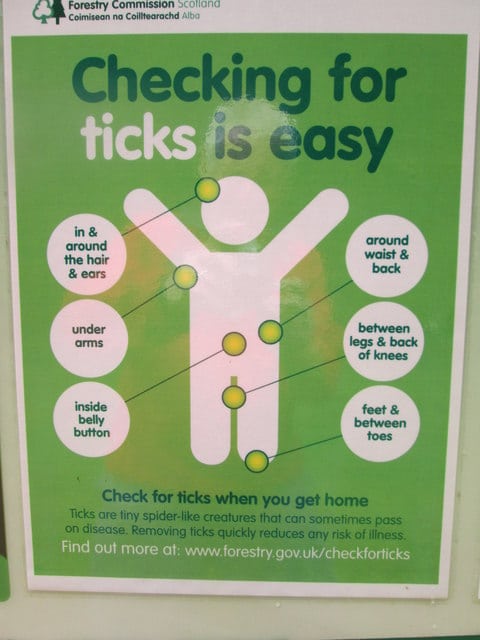 Tick checks are the most important part of battling ticks. Check often, and check thoroughly when you are done your outdoor activity. Once you discover a tick on you, your gear, in your car or in your bed to fuel your nightmares, you will quickly discover one of the most maddening aspects of ticks. Suddenly you see and feel phantom ticks everywhere, locking you in a state of hyper-vigilant paranoia.
Tick checks are the most important part of battling ticks. Check often, and check thoroughly when you are done your outdoor activity. Once you discover a tick on you, your gear, in your car or in your bed to fuel your nightmares, you will quickly discover one of the most maddening aspects of ticks. Suddenly you see and feel phantom ticks everywhere, locking you in a state of hyper-vigilant paranoia.
A certain degree of paranoia is good to remind you to do tick checks, but it is a balancing act to maintain sanity and enjoyment. Check yourself at every break, have a quick look after walking through bushes or tall grass, and a thorough check when you’re done your outdoor activities. This amount of checking is enough to stay safe without being in a constant state of hyper-vigilance. Keep in mind that for a tick to transmit Lyme disease, it typically needs to be attached for at least 24 hours, so catching them early is key.
The ticks that cause the most problems are nymphs as small as 2mm, or the size of a tiny ant. That small size is precisely why they are the cause of the majority of Lyme cases. Spotting something of this size requires a thorough inspection. To help with these checks, I carry a lint roller to give myself an airport-style screening after any outdoor activity. Thoroughly examine your backpack and gear before placing it in your car, tent or home. If you’re exhausted and not in the mood, have a heavy-duty contractor garbage bag to put your gear in and keep it outside before you can thoroughly check it. Wash your clothes and shower asap to wash off anything you missed and have a final thorough check.
Tick Repellents
From my experience, traditional repellents such as DEET are not nearly as effective against ticks as they are against flies. My philosophy is to save chemical repellents as a last resort when you’re in a place that you know is full of ticks and/or heavy levels of bugs. From my years of tree planting amongst ungodly levels of insects, most of us opted for full body bug jackets over chemical spray, but often used both to maintain sanity:
Icaridin is a modern alternative to DEET, and is said to be less harmful and just as effective. I put it in the same category as DEET as far as its effectiveness against ticks. Both are very effective with flies, but more of a mere annoyance to ticks.
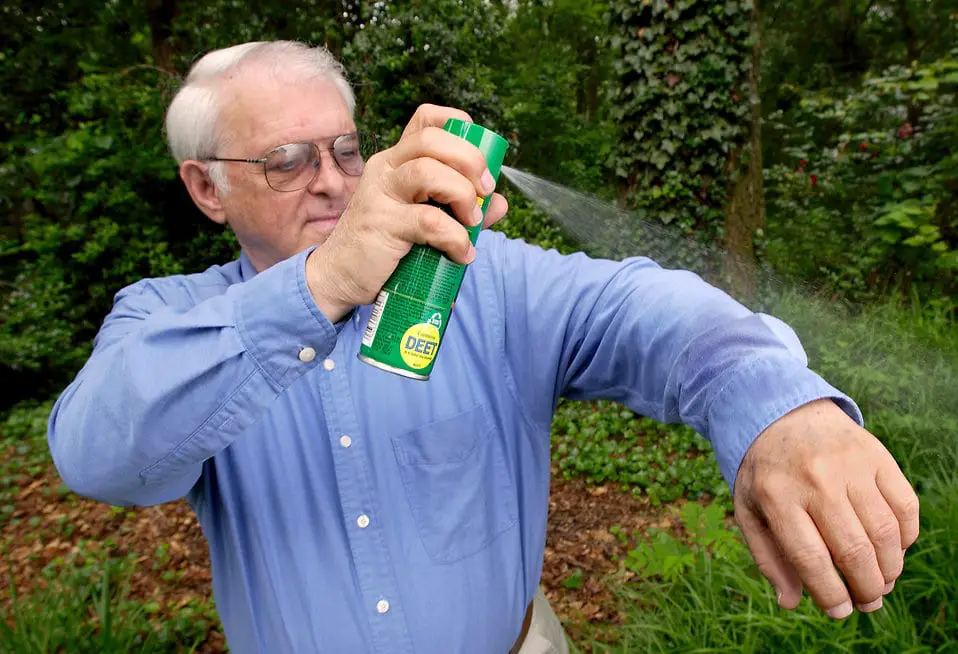 Nowadays I try to reduce exposure to harsh chemicals unless it’s an overwhelming bug situation. As for ticks, the only highly effective chemical defence I have used is Permethrin. My Permethrin-treated gear has almost never retained ticks, even in areas where my companions with non-treated gear had many. Canada’s approach to this pesticide is baffling, especially in the face of the Lyme epidemic. The Canadian government’s own advice is to use Permethrin, yet it is not possible to buy in Canada. This hindrance is not shared by our American neighbours where it is readily available.
Nowadays I try to reduce exposure to harsh chemicals unless it’s an overwhelming bug situation. As for ticks, the only highly effective chemical defence I have used is Permethrin. My Permethrin-treated gear has almost never retained ticks, even in areas where my companions with non-treated gear had many. Canada’s approach to this pesticide is baffling, especially in the face of the Lyme epidemic. The Canadian government’s own advice is to use Permethrin, yet it is not possible to buy in Canada. This hindrance is not shared by our American neighbours where it is readily available.
The odd restrictions don’t apply to certain clothing brands who are now offering (often costly) pre-treated permethrin-infused products. Further adding to the confusion, the clothing has to be marketed as mosquito and fly repellent without touting the Permethrin tick prevention aspect. This can be seen with Mark’s Work Warehouse’s line of permethrin-treated clothing (not a paid promotion).
If you’re able to buy Permethrin, make sure you apply it safely. As with any chemical, read about proper usage first. Don’t use it on your skin, only treat gear that will not be in direct contact with your skin. A single treatment lasts through many washes so you don’t need to re-apply it often.
Gear Up at Shop.Halifaxtrails.ca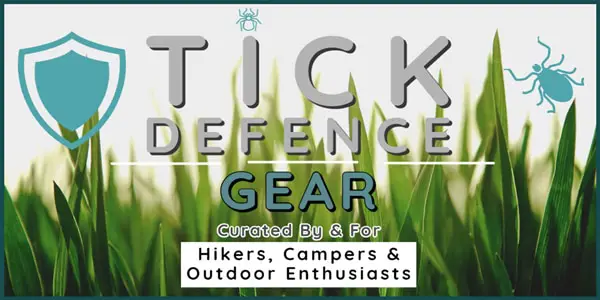
I think it’s worthwhile to experiment with all-natural repellents as they are likely to work as well as DEET, without the chemicals. A local Nova Scotian company called “Atlantick” offers such a product (not a paid promotion). I’ve used it for one season and not had a tick with it yet (anecdotal evidence to be sure). While Atlantick smells much nicer than DEET, I find it’s not as effective against flies (also not its stated purpose). It costs considerably more than DEET, but it seems to be worth my investment so far.
I also like these all-natural patches for light levels of flies (don’t expect a miracle). Mosquito coils and these new Thermacell devices are also great for clearing your campsite or rest area.
Hitchhiking Ticks
 One of the insidious ways ticks can continue to wreak havoc on you is to hitch a ride home and appear in unexpected places days or weeks later. Ticks are like velcro and are not easy to brush off. Once they are on you, they often require more than just a swipe. Their gripping attributes make them highly adept at hitching a ride.
One of the insidious ways ticks can continue to wreak havoc on you is to hitch a ride home and appear in unexpected places days or weeks later. Ticks are like velcro and are not easy to brush off. Once they are on you, they often require more than just a swipe. Their gripping attributes make them highly adept at hitching a ride.
I always say it’s best to treat yourself and your gear as if it’s come in contact with an infectious disease. Careful handling, and examination before bringing it into your car or home is a must. For me, that means examing every inch of myself and my gear before getting in the car. If you don’t have company to check your back, snapping pictures with your phone is better than nothing. I always keep a lint roller in my car for post-hike tick checks, as well as an XL heavy duty contractor grade garbage bag to throw my backpack and other gear into. If I’m too tired to spend the proper amount of time examining my gear before I head home, I know the ticks are going to be confined to the garbage bag.
When I get home, I do another quick check before walking in the house, leave my gear and boots outside, throw my clothes in the wash, and have a shower immediately. Get to know yourself more intimately than you ever wanted to with the aid of a telescoping mirror, and have a thorough wash with a cloth, bath brush or other scrubbing agents.
Kids and pets require special attention. Pets are tick magnets and are much more difficult to do a thorough check. The use of pet anti-tick medication is good, but definitely not foolproof when it comes to bringing ticks home. A flea comb and tick remover are good tools for your arsenal. Not letting your pets run through the aforementioned tick habitat is the best way to avoid them in the first place.
2) Tick Bites
- Avoid hasty removal.
- Carry a tick remover.
- Clean with alcohol wipes.
- Storing, Reporting & Treating.
- Monitor bites.
Avoid Improper Removal
Discovering you’ve got a tick attached to you is a sinking feeling the first couple of times it happens to you. Your first instinct may be to freak out and rip it off as fast as possible, but that is one of the worst things you can do. Improper removal can result in squeezing nastiness into you, and result in an incomplete removal. Proper removal is quick, painless and clean.
Ticks are darn near indestructible and can live for a long time in almost any environment. Unlike most insects, they are nearly un-squashable due to their armour plating. Putting them through a wash cycle is no guarantee of killing them. The hot dry air of a dyer is likely to kill them but doesn’t always ensure their demise. They can live for months without feeding as they patiently wait for their next victim and live for years in a normal life cycle. Unlike most insects, ticks require special attention to ensure permanent banishment. Drown them in alcohol, seal them up with tape or take other such deliberate measures to ensure their demise.
Tick Removers
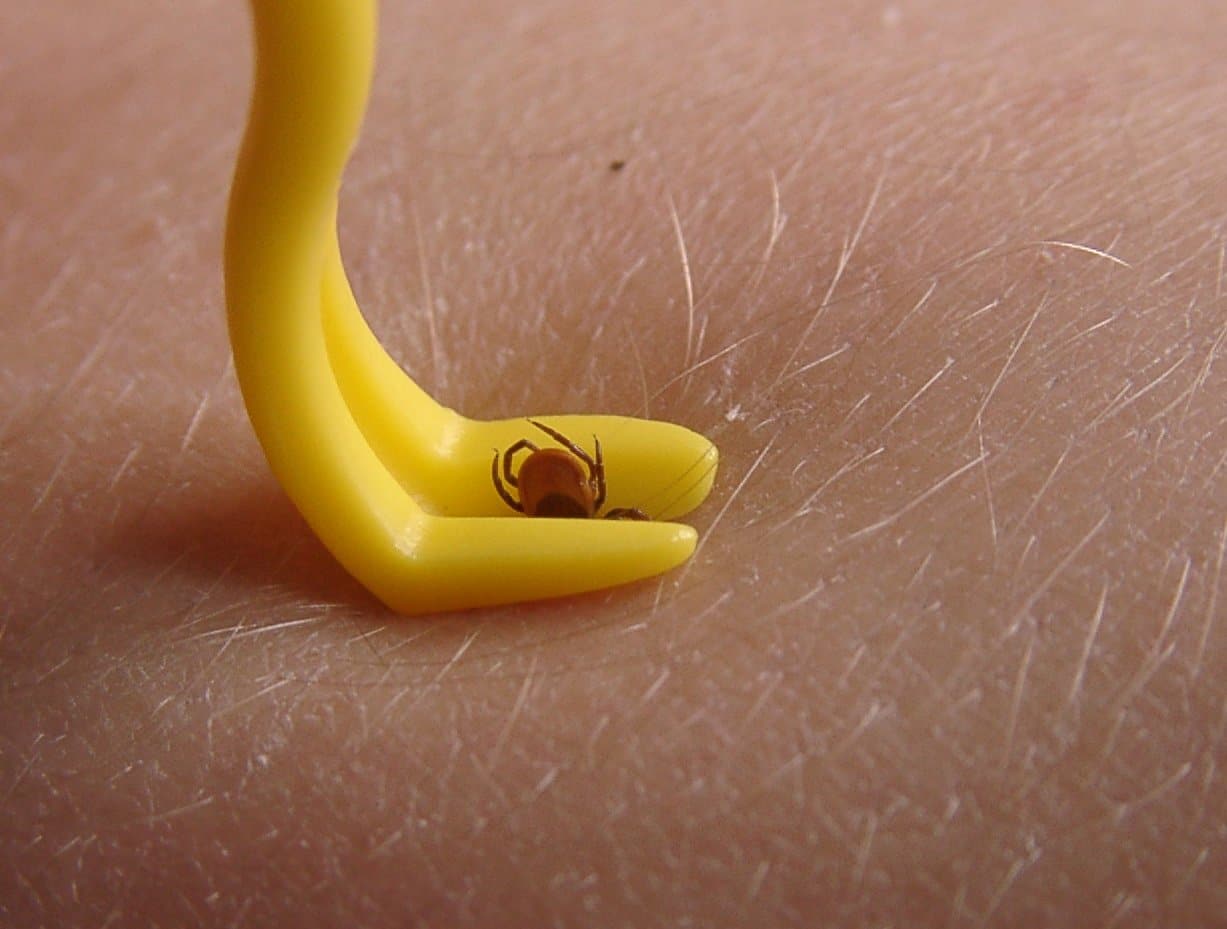 The best thing you can do for tick removal is to have a proper tick remover on hand. The best kind is simply the one that you will always carry with you. Have it in your backpack, attached to your keyring, in your wallet, or something that you will always have when you’re outdoors. Tweezers work in a pinch but aren’t as simple and straightforward for clean removal. Especially if you have a pet, you should own a few tick removers.
The best thing you can do for tick removal is to have a proper tick remover on hand. The best kind is simply the one that you will always carry with you. Have it in your backpack, attached to your keyring, in your wallet, or something that you will always have when you’re outdoors. Tweezers work in a pinch but aren’t as simple and straightforward for clean removal. Especially if you have a pet, you should own a few tick removers.
Alcohol Wipes
If you are bitten, cleaning the bite area with an alcohol wipe is a good insurance policy. Ensuring there are no harmful bacteria on or around the bite will help prevent any future problems that might arise. You should always have alcohol wipes along with a tick remover in your first-aid kit. A first-aid kit is as vital as water and a compass. Even for quick outings, always pack a compact, lightweight kit.
Storing, Reporting & Treating
The last thing you may want to do after a tick-removing freakout is to store it as a panic-inducing trophy. Keeping the tick does, however, serve an important purpose for identification and assessment. Keep in mind that Canada is far behind the curve when it comes to testing people for Lyme so don’t expect your tick to get sent off to the lab.
It is helpful for your own reference to identify the different types of ticks, specifically the problematic deer tick. A new website and accompanying app allow you to report the ticks and have them identified by experts. This “citizen science project” is a partnership of various academic institutions and Canadian public health agencies and looks to be a promising source of useful data.
Pharmacists in Nova Scotia and many other places now offer free tick-bite assessment and treatment. They are now able to prescribe antibiotics for preventative treatment if their assessment warrants it. These assessments are now a free service in Nova Scotia and treatment can be prescribed within a 72-hour window after the tick is removed.
Monitoring Tick Bites
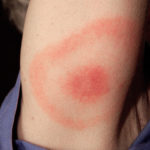
If you are bitten, it’s important to monitor the site of the bite for any abnormalities in the days that follow. If you notice any changes on your skin, specifically a bullseye rash, see a doctor or pharmacist immediately. The rash is commonly but not always associated with Lyme. Pay attention to your health and note any changes in how you feel. If you notice any abnormalities, specifically headaches, swelling, or flu-like symptoms, see a doctor or pharmacist immediately. These symptoms may develop anywhere from 3-30 days after the bite, but typically within 7 days.
3) Important Info
Lyme Disease Transmission
According to Health Canada, ticks need to be attached for 24-48 hours to transmit Lyme disease. There are ongoing debates into this timeframe, as others say the tick does not have to be attached for this period of time, in unusual cases. This is good news if you are vigilant with your tick checks and tick prevention. If you don’t bring them into your living quarters and check early and often you will be in the clear. Lyme is most often associated with a bulls-eye rash, but not always. Symptoms can be wide-ranging, from intense headaches to flu-like symptoms and many things in between. If you are experiencing any health changes at all after being bitten by a tick, see your doctor immediately. Quick diagnosis and treatment are key to ensuring no long-term health effects. Lyme is carried specifically by the Deer Tick aka Black-Legged tick, so it is helpful to preserve ticks that bite you for further identification and possible future testing.

Black-Legged Ticks
Black-legged ticks, or deer ticks, are the only species of tick that carry Lyme Disease. While it’s good to avoid all ticks, these deserve special attention. Learning how to identify them is valuable knowledge to have. Your first few encounters with ticks, you may have trouble identifying them. Pay attention to all ticks you see and you’ll soon be able to spot the differences.
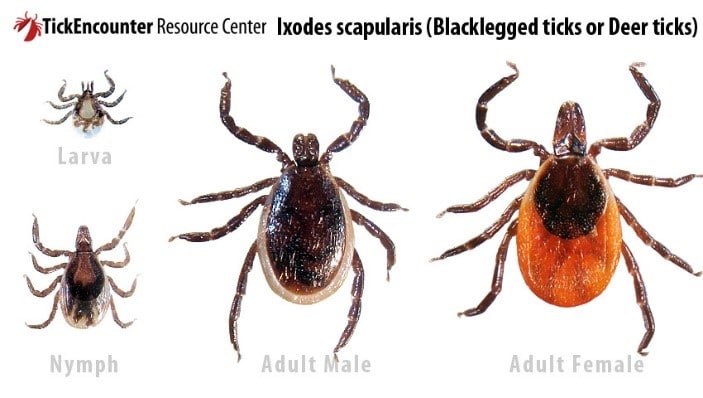
Nymphs
Most people are afraid of the bigger, fully grown ticks as they are more menacing looking and their bites can hurt. For those two reasons, it is less likely you have to worry about fully grown ticks. Adult ticks are much easier to spot and to feel, so you have a high likelihood of removing them before the 24-hour minimum.
Nymphs and immature ticks are much more difficult to see and feel, thus requiring up-close, thorough checks. Nymphs can be less than 2mm in size, making them as difficult to spot as a small ant.
Summary
I now look back on the good old days when swarms of mosquitos, black flies and deer flies used to be the worst of God’s creatures. Thanks to the climate crisis, ticks have now taken that crown here in Nova Scotia where they did not exist to any significant degree just a few years ago. An interesting read on this subject is “Lyme: The First Epidemic Of Climate Change” by Mary Beth Pfeiffer.
The diagnosis and treatment of Lyme disease in Canada is extremely unreliable and inadequate. Our government is far behind where it should be in battling this epidemic. That means it’s up to you to avoid it.
All of this is to say that you should not let ticks spoil your enjoyment of nature. Everything mentioned in this guide is in an abundance of caution. Your chance of contracting a tick-borne illness, though constantly rising, is still very low. With the proper amount of preparation, awareness and vigilance detailed in this guide, you’ll be safe from ticks and their pathogens.
This is our new normal, but you should push your representatives in government to address the Lyme epidemic with the urgency it requires. The Canadian Lyme Disease Foundation is a non-profit organization doing just that. We need to ensure our testing, treatment and preventive measures are far better than they are now.
- The Best Hiking Trails Near Halifax For Every Kind Of Hiker - July 8, 2021
- Nova Scotia’s Climate Emergency - March 26, 2021
- The Road To Recovery: Nature Rehab For Body & Mind - January 29, 2020
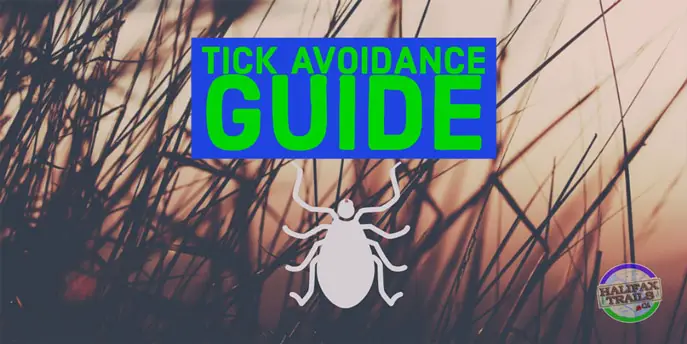
3 replies on “A Detailed Guide To Avoiding Ticks”
Great article Greg. Had Lymne twice (2014 & 2015). I too am frustrated with our government polices. Just ordered Sawyer Picardin repellent (proven more effective than Deet & doesn’t melt plastics) as well as Sawyer Permethrine to spray my clothes & tent door from Sunny Sports in NY. I’ve ordered from them before. Reasonably priced at 7.99 us each, it costs me $30.00 us for shipping since our gov. hasn’t approved either product. Mindboggling that our government is not allowing these products, especially since we spray permethrine on the outside of clothing.
I too avoid walking thru brush & camping in areas covered with old leaves. I’ve spotted these things hanging on the mesh of my tent entrance & have mostly been bitten after going to bed so that’s why I think it’s important to spray around the tent entrance. Cheers
Twice, wow. It is crazy how far behind Canada is in seriously addressing this problem. Thanks for those tips, very helpful. Camping is always my main concern with ticks too, once they’re in your tent you’re a sitting duck. Thanks for taking the time to offer some positive feedback. Much appreciated!
Hi Greg. Thanks for the article, good read with some great info. Just wanted to mention a few things that I have experienced. I live in Lunenburg area and would mention that your chances of getting Lyme are actually quite high, not low if you spend time outdoors. I have had it twice in 5 years. Also I do not find that the Atlantick product works, not in anyway that I would trust it.
These things are a real problem especially when you have kids that do not stay on paths. In fact, because I want them to, the tall grass is that much more alluring.
Thanks again.